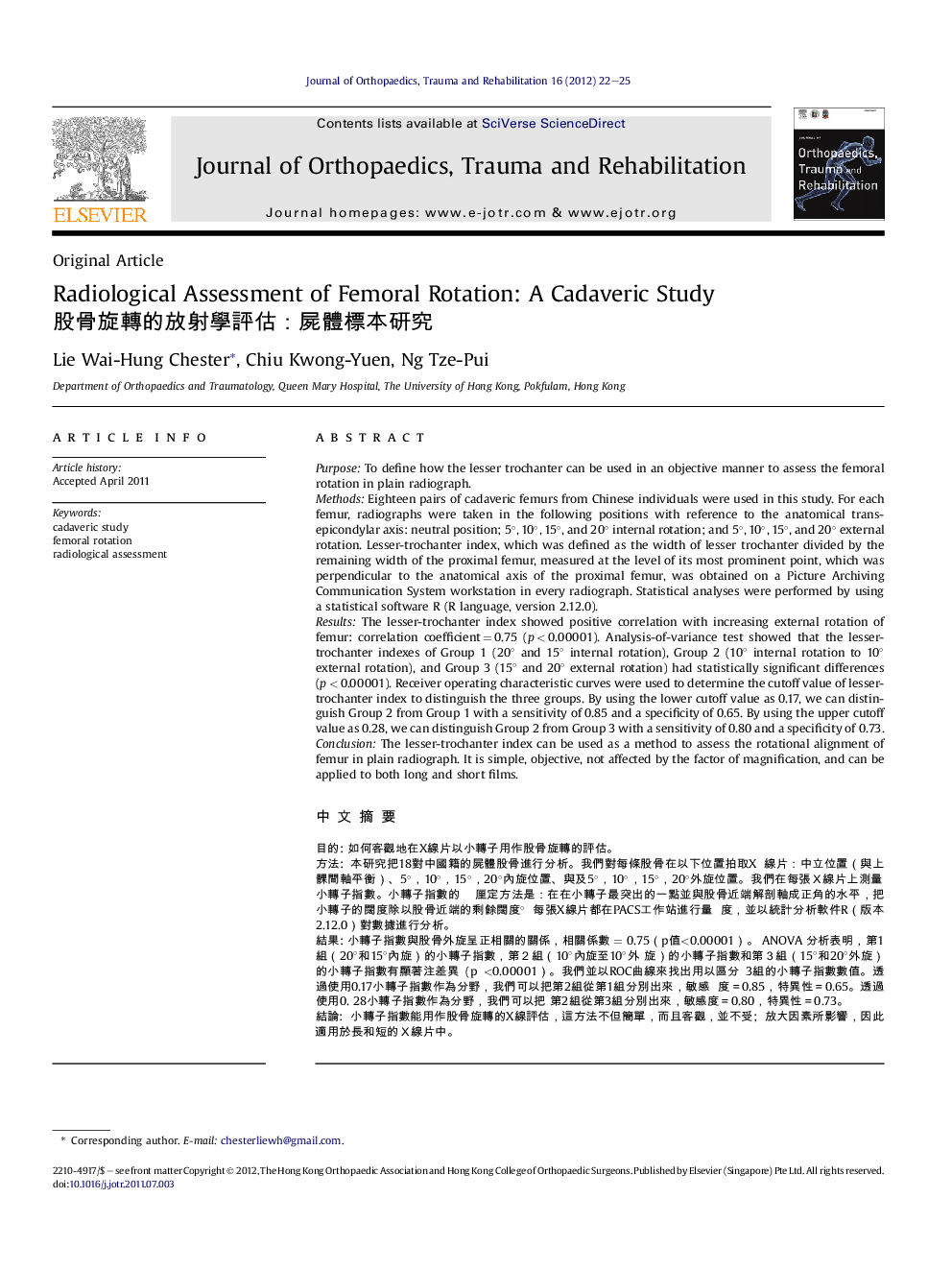| کد مقاله | کد نشریه | سال انتشار | مقاله انگلیسی | نسخه تمام متن |
|---|---|---|---|---|
| 4072601 | 1266953 | 2012 | 4 صفحه PDF | دانلود رایگان |

PurposeTo define how the lesser trochanter can be used in an objective manner to assess the femoral rotation in plain radiograph.MethodsEighteen pairs of cadaveric femurs from Chinese individuals were used in this study. For each femur, radiographs were taken in the following positions with reference to the anatomical transepicondylar axis: neutral position; 5°, 10°, 15°, and 20° internal rotation; and 5°, 10°, 15°, and 20° external rotation. Lesser-trochanter index, which was defined as the width of lesser trochanter divided by the remaining width of the proximal femur, measured at the level of its most prominent point, which was perpendicular to the anatomical axis of the proximal femur, was obtained on a Picture Archiving Communication System workstation in every radiograph. Statistical analyses were performed by using a statistical software R (R language, version 2.12.0).ResultsThe lesser-trochanter index showed positive correlation with increasing external rotation of femur: correlation coefficient = 0.75 (p < 0.00001). Analysis-of-variance test showed that the lesser-trochanter indexes of Group 1 (20° and 15° internal rotation), Group 2 (10° internal rotation to 10° external rotation), and Group 3 (15° and 20° external rotation) had statistically significant differences (p < 0.00001). Receiver operating characteristic curves were used to determine the cutoff value of lesser-trochanter index to distinguish the three groups. By using the lower cutoff value as 0.17, we can distinguish Group 2 from Group 1 with a sensitivity of 0.85 and a specificity of 0.65. By using the upper cutoff value as 0.28, we can distinguish Group 2 from Group 3 with a sensitivity of 0.80 and a specificity of 0.73.ConclusionThe lesser-trochanter index can be used as a method to assess the rotational alignment of femur in plain radiograph. It is simple, objective, not affected by the factor of magnification, and can be applied to both long and short films.
中文摘要目的如何客觀地在X線片以小轉子用作股骨旋轉的評估。方法本研究把18對中國籍的屍體股骨進行分析。我們對每條股骨在以下位置拍取X 線片:中立位置(與上髁間軸平衡)、5°,10°,15°,20°內旋位置、與及5°,10°,15°,20°外旋位置。我們在每張X線片上測量小轉子指數。小轉子指數的 厘定方法是:在在小轉子最突出的一點並與股骨近端解剖軸成正角的水平,把 小轉子的闊度除以股骨近端的剩餘闊度° 每張X線片都在PACS工作站進行量 度,並以統計分析軟件R(版本2.12.0)對數據進行分析。結果小轉子指數與股骨外旋呈正相關的關係,相關係數 = 0.75(p值<0.00001)。 ANOVA 分析表明,第1組(20°和15°內旋)的小轉子指數,第2組(10°內旋至10°外 旋)的小轉子指數和第3組(15°和20°外旋)的小轉子指數有顯著注差異 (p <0.00001)。我們並以ROC曲線來找出用以區分 3組的小轉子指數數值。透 過使用0.17小轉子指數作為分野,我們可以把第2組從第1組分別出來,敏感 度=0.85,特異性=0.65。透過使用0. 28小轉子指數作為分野,我們可以把 第2組從第3組分別出來,敏感度=0.80,特異性=0.73。結論小轉子指數能用作股骨旋轉的X線評估,這方法不但簡單,而且客觀,並不受; 放大因素所影響,因此適用於長和短的X線片中。
Journal: Journal of Orthopaedics, Trauma and Rehabilitation - Volume 16, Issue 1, June 2012, Pages 22–25